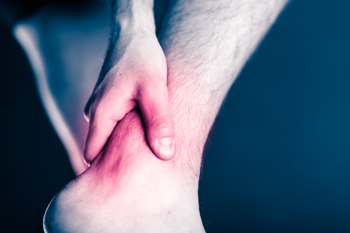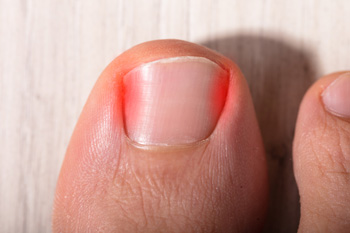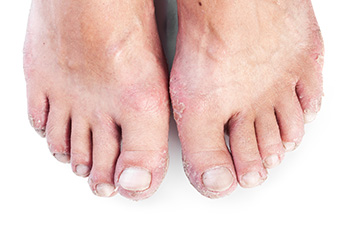Items filtered by date: June 2024
Treatment Options for an Achilles Tendon Tear

An Achilles tendon tear, whether partial or complete, is a serious injury often caused by sudden, forceful movements during sports or activities. Symptoms of an Achilles tendon tear include sharp pain, swelling, bruising, and difficulty pointing the foot or standing on tiptoe. Treatment options vary depending on the severity of the tear. Partial tears can often be managed conservatively with immobilization using a cast, splint, brace, or walking boot. This is followed by a structured rehabilitation program to restore strength and flexibility gradually. Complete tears typically require surgical intervention to reattach the tendon ends and ensure optimal healing. Following surgery, a thorough rehabilitation plan is essential to regain full function and reduce the risk of re-injury. If you suspect an Achilles tendon tear or experience symptoms like sudden pain and restricted movement, it is suggested that you seek an appointment with a podiatrist for a full exam and tailored treatment plan.
Achilles tendon injuries need immediate attention to avoid future complications. If you have any concerns, contact Kent Stahl, DPM of Texas. our doctor can provide the care you need to keep you pain-free and on your feet.
What Is the Achilles Tendon?
The Achilles tendon is a tendon that connects the lower leg muscles and calf to the heel of the foot. It is the strongest tendon in the human body and is essential for making movement possible. Because this tendon is such an integral part of the body, any injuries to it can create immense difficulties and should immediately be presented to a doctor.
What Are the Symptoms of an Achilles Tendon Injury?
There are various types of injuries that can affect the Achilles tendon. The two most common injuries are Achilles tendinitis and ruptures of the tendon.
Achilles Tendinitis Symptoms
- Inflammation
- Dull to severe pain
- Increased blood flow to the tendon
- Thickening of the tendon
Rupture Symptoms
- Extreme pain and swelling in the foot
- Total immobility
Treatment and Prevention
Achilles tendon injuries are diagnosed by a thorough physical evaluation, which can include an MRI. Treatment involves rest, physical therapy, and in some cases, surgery. However, various preventative measures can be taken to avoid these injuries, such as:
- Thorough stretching of the tendon before and after exercise
- Strengthening exercises like calf raises, squats, leg curls, leg extensions, leg raises, lunges, and leg presses
If you have any questions please feel free to contact our office located in Beaumont, TX . We offer the newest diagnostic tools and technology to treat your foot and ankle needs.
Ingrown Toenails Are a Serious Foot Condition
 Ingrown toenails occur when the edge of a toenail grows into the surrounding skin, causing pain, swelling, and sometimes infection. They often result from improper nail trimming, wearing tight footwear, or injury to the toe. Genetic predisposition and certain activities that put pressure on the toes, such as running or ballet, can also contribute to this condition. People with curved or thick nails are more susceptible to ingrown toenails. Symptoms include redness, tenderness, and sometimes pus if an infection develops. If left untreated, the pain can intensify, making walking difficult. To find relief for an ingrown toenail, soak the foot in warm water to reduce swelling, and gently lift the nail away from the skin using a cotton ball or dental floss. Prevent ingrown toenails by trimming nails straight across, wearing properly fitting shoes, and avoiding trauma to the toes. If you have a persistent or severe ingrown toenail, it is suggested that you schedule an appointment with a podiatrist for professional treatment and guidance.
Ingrown toenails occur when the edge of a toenail grows into the surrounding skin, causing pain, swelling, and sometimes infection. They often result from improper nail trimming, wearing tight footwear, or injury to the toe. Genetic predisposition and certain activities that put pressure on the toes, such as running or ballet, can also contribute to this condition. People with curved or thick nails are more susceptible to ingrown toenails. Symptoms include redness, tenderness, and sometimes pus if an infection develops. If left untreated, the pain can intensify, making walking difficult. To find relief for an ingrown toenail, soak the foot in warm water to reduce swelling, and gently lift the nail away from the skin using a cotton ball or dental floss. Prevent ingrown toenails by trimming nails straight across, wearing properly fitting shoes, and avoiding trauma to the toes. If you have a persistent or severe ingrown toenail, it is suggested that you schedule an appointment with a podiatrist for professional treatment and guidance.
Ingrown toenails can become painful if they are not treated properly. For more information about ingrown toenails, contact Kent Stahl, DPM of Texas. our doctor can provide the care you need to keep you pain-free and on your feet.
Ingrown Toenails
Ingrown toenails occur when a toenail grows sideways into the bed of the nail, causing pain, swelling, and possibly infection.
Causes
- Bacterial infections
- Improper nail cutting such as cutting it too short or not straight across
- Trauma to the toe, such as stubbing, which causes the nail to grow back irregularly
- Ill-fitting shoes that bunch the toes too close together
- Genetic predisposition
Prevention
Because ingrown toenails are not something found outside of shoe-wearing cultures, going barefoot as often as possible will decrease the likeliness of developing ingrown toenails. Wearing proper fitting shoes and using proper cutting techniques will also help decrease your risk of developing ingrown toenails.
Treatment
Ingrown toenails are a very treatable foot condition. In minor cases, soaking the affected area in salt or antibacterial soaps will not only help with the ingrown nail itself, but also help prevent any infections from occurring. In more severe cases, surgery is an option. In either case, speaking to your podiatrist about this condition will help you get a better understanding of specific treatment options that are right for you.
If you have any questions please feel free to contact our office located in Beaumont, TX . We offer the newest diagnostic and treatment technologies for all your foot and ankle needs.
Why Live with Pain and Numbness in Your Feet?
Help for Psoriatic Arthritis of the Feet
 Psoriasis of the feet, particularly palmoplantar psoriasis is a chronic skin condition characterized by thickened, red, and scaly patches on the soles. This form is often accompanied by painful fissures and can severely impact mobility. Another variant, localized pustular psoriasis, presents as pus-filled blisters surrounded by inflamed skin. Nail involvement is common, leading to pitting, discoloration, and onycholysis, or separation of the nail from the nail bed. Triggers for psoriasis include stress, infections, skin injuries, and certain medications. Diagnosis is primarily clinical, supported by a skin biopsy if necessary. Treatments range from topical therapies like corticosteroids and vitamin D analogs to systemic treatments, including biologics and oral medications for more severe cases. Phototherapy is another effective option. In refractory cases, surgical intervention may be considered to remove painful, thickened plaques. If you have discomfort in the feet from psoriasis, it is suggested that you schedule an appointment with a podiatrist for optimal management and personalized care.
Psoriasis of the feet, particularly palmoplantar psoriasis is a chronic skin condition characterized by thickened, red, and scaly patches on the soles. This form is often accompanied by painful fissures and can severely impact mobility. Another variant, localized pustular psoriasis, presents as pus-filled blisters surrounded by inflamed skin. Nail involvement is common, leading to pitting, discoloration, and onycholysis, or separation of the nail from the nail bed. Triggers for psoriasis include stress, infections, skin injuries, and certain medications. Diagnosis is primarily clinical, supported by a skin biopsy if necessary. Treatments range from topical therapies like corticosteroids and vitamin D analogs to systemic treatments, including biologics and oral medications for more severe cases. Phototherapy is another effective option. In refractory cases, surgical intervention may be considered to remove painful, thickened plaques. If you have discomfort in the feet from psoriasis, it is suggested that you schedule an appointment with a podiatrist for optimal management and personalized care.
Arthritis can be a difficult condition to live with. If you are seeking treatment, contact Kent Stahl, DPM from Texas. our doctor can provide the care you need to keep you pain-free and on your feet.
Arthritic Foot Care
Arthritis is a term that is commonly used to describe joint pain. The condition itself can occur to anyone of any age, race, or gender, and there are over 100 types of it. Nevertheless, arthritis is more commonly found in women compared to men, and it is also more prevalent in those who are overweight. The causes of arthritis vary depending on which type of arthritis you have. Osteoarthritis for example, is often caused by injury, while rheumatoid arthritis is caused by a misdirected immune system.
Symptoms
- Swelling
- Pain
- Stiffness
- Decreased Range of Motion
Arthritic symptoms range in severity, and they may come and go. Some symptoms stay the same for several years but could potentially get worse with time. Severe cases of arthritis can prevent its sufferers from performing daily activities and make walking difficult.
Risk Factors
- Occupation – Occupations requiring repetitive knee movements have been linked to osteoarthritis
- Obesity – Excess weight can contribute to osteoarthritis development
- Infection – Microbial agents can infect the joints and trigger arthritis
- Joint Injuries – Damage to joints may lead to osteoarthritis
- Age – Risk increases with age
- Gender –Most types are more common in women
- Genetics – Arthritis can be hereditary
If you suspect your arthritis is affecting your feet, it is crucial that you see a podiatrist immediately. Your doctor will be able to address your specific case and help you decide which treatment method is best for you.
If you have any questions, please feel free to contact our office located in Beaumont, TX . We offer the newest diagnostic and treatment technologies for all your foot care needs.
Rheumatoid Arthritis and Foot Swelling
 Rheumatoid arthritis, or RA, is an autoimmune disease that primarily affects joints, frequently targeting the feet and ankles. Common symptoms include swelling, pain, and inflammation in the affected joints. In RA, the immune system mistakenly attacks the joint lining, leading to chronic inflammation that can damage the joints and surrounding tissues over time. As a result, the foot and ankle joints often become swollen and painful, which can make walking and standing uncomfortable or even debilitating. The swelling is often symmetrical, meaning it typically affects the same joints on both sides of the body simultaneously. Treatment may include medication to reduce inflammation and slow disease progression. Targeted stretching to maintain joint function and orthotics to support the joints and alleviate pressure are other possible measures. Regular visits to a podiatrist, or foot doctor, are important for those with RA to monitor their foot health. If you suffer from rheumatoid arthritis and the associated swelling in the feet and ankles, it is suggested you make an appointment with a podiatrist today.
Rheumatoid arthritis, or RA, is an autoimmune disease that primarily affects joints, frequently targeting the feet and ankles. Common symptoms include swelling, pain, and inflammation in the affected joints. In RA, the immune system mistakenly attacks the joint lining, leading to chronic inflammation that can damage the joints and surrounding tissues over time. As a result, the foot and ankle joints often become swollen and painful, which can make walking and standing uncomfortable or even debilitating. The swelling is often symmetrical, meaning it typically affects the same joints on both sides of the body simultaneously. Treatment may include medication to reduce inflammation and slow disease progression. Targeted stretching to maintain joint function and orthotics to support the joints and alleviate pressure are other possible measures. Regular visits to a podiatrist, or foot doctor, are important for those with RA to monitor their foot health. If you suffer from rheumatoid arthritis and the associated swelling in the feet and ankles, it is suggested you make an appointment with a podiatrist today.
Because RA affects more than just your joints, including the joints in your feet and ankles, it is important to seek early diagnosis from your podiatrist if you feel like the pain in your feet might be caused by RA. For more information, contact Kent Stahl, DPM of Texas. our doctor will assist you with all of your podiatric concerns.
What Is Rheumatoid Arthritis?
Rheumatoid Arthritis (RA) is an autoimmune disorder in which the body’s own immune system attacks the membranes surrounding the joints. Inflammation of the lining and eventually the destruction of the joint’s cartilage and bone occur, causing severe pain and immobility.
Rheumatoid Arthritis of the Feet
Although RA usually attacks multiple bones and joints throughout the entire body, almost 90 percent of cases result in pain in the foot or ankle area.
Symptoms
- Swelling and pain in the feet
- Stiffness in the feet
- Pain on the ball or sole of feet
- Joint shift and deformation
Diagnosis
Quick diagnosis of RA in the feet is important so that the podiatrist can treat the area effectively. Your doctor will ask you about your medical history, occupation, and lifestyle to determine the origin of the condition. Rheumatoid Factor tests help to determine if someone is affected by the disease.
If you have any questions please feel free to contact our office located in Beaumont, TX . We offer the newest diagnostic and treatment technologies for all your foot and ankle needs.

